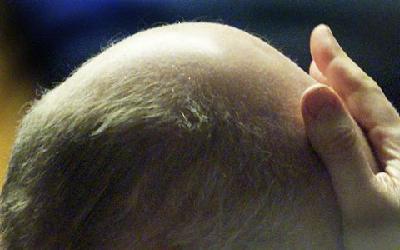
BARBARA KLEIN: This is SCIENCE IN THE NEWS in VOA Special English. I'm Barbara Klein.
STEVE EMBER: And I'm Steve Ember. Today we talk about hair. We will tell what hair is, how it grows, and some of the main reasons people lose it.
(MUSIC)
BARBARA KLEIN: Hair has always been an important sign of beauty. This is especially true for women. Next to the face, hair is one of the main qualities people look for when they consider a woman's beauty. Whether long or short, curly or straight, hair often gets a lot of attention. People who have it value it. Those of us who do not often mourn its loss.
STEVE EMBER: Each hair on a person's head grows from a single tube-like hole in the skin called a follicle. People are born with all of the hair follicles they are ever going to have. The average person has about 100,000 hair follicles. They begin to form on a fetus around the third month of pregnancy.
The part of the hair under the skin is known as the hair root. The hair sticking out from the skin is known as the hair shaft. The shaft is made up of dead cells that have been pushed up through the root. At the base of the hair root is a small ball-like formation called a bulb. This is where new cells are formed. These cells receive nutrition from the blood supply under the skin.
BARBARA KLEIN: As new cells form, the older cells are pushed up through the root. In time, the old cells are cut off from the blood supply and begin to form a hard protein called keratin. Keratin is the same protein found in our skin and nails. These dead cells and keratin are what make up the hair shaft. This whole process is what causes hair to grow.
Each hair grows independently of other hairs. There are three periods of hair growth. Not all hairs experience the same period of growth at the same time. The period of active growth is called Anagen. During this period, hair grows at a rate of about three tenths millimeters a day, or one centimeter a month. About 85 percent of hair follicles are going through this process at any given time. This period can last from two to six years.
STEVE EMBER: The Catagen period of hair growth comes next. It is then that hair growth begins to slow down. This period usually lasts two or three weeks. Finally, hair growth comes to a complete stop and the hairs begin to fall out. This period is known as telogen. It affects about 15 percent of all hairs at a time.
On average, a person loses between 50 and 100 hairs every day. Since each hair grows at a different rate, this process is overlooked. Once the telogen period has ended, the hair growth process begins again.
(MUSIC)
BARBARA KLEIN: So what happens when a person has trouble growing hair or suffers from hair loss? Your genes control how fast or how long your hair will grow. Some people have a longer than usual anagen growth period. These people may be able to grow more hair than the average person. However, others struggle to grow shoulder length hair. These people have a shorter than normal anagen period.
Your health can also affect hair growth. Poor nutrition can cause some hair follicles to stop growing or cause the hairs that grow to become weak or thin. Problems with hair growth can result from thyroid problems or other conditions like anemia, diabetes and lupus. Health experts say people who experience a sudden increase in hair loss should seek medical advice.
STEVE EMBER: Some hair loss can result from a combination of genetics, aging and hormones. When this happens, the hair growth cycle changes and the hair follicles get smaller. In addition, the hairs may get thinner and shorter. Soon the hairs stop growing completely on some parts of the head. People with this condition usually have family members who have experienced similar hair losses. This kind of hair loss is known as pattern baldness. It is the most common kind of hair loss. The official medical term for the condition is androgenetic alopecia.
BARBARA KLEIN: The Latin word alopecia means loss of hair or baldness. It is also the term used to describe the medical condition that results in the loss of hair. Alopecia areata is the second most common form of hair loss after pattern baldness. It is the most common form of autoimmune disease. In alopecia areata, the body's defenses against disease attack the hair follicles, resulting in a loss of hair on the scalp and other parts of the body.
The condition usually begins with small round areas of hair loss on the scalp. When hair loss takes place over the whole surface of the scalp, it is called alopecia areata totalis. Sometimes a person may lose their eyebrows, eyelashes or hair on other parts of the body. This condition is called alopecia areata universalis. It is the rarest form of alopecia.
(MUSIC)
STEVE EMBER: The National Alopecia Areata Foundation says alopecia areata affects about two percent of the population. About five million people in the United States have the condition. It affects people of all ages and races, and often begins in childhood.
That was true of 22 year old Kayla Martell, the winner of the Miss Delaware Pageant last year. Ms. Martell began losing her hair when she was about ten years old. By the time she was 13, all of her hair had come out.
BARBARA KLEIN: Kayla Martell began competing in beauty pageants around that same time. In many of the events, she competed without hair. In fact, three of the five times she attempted to become Miss Delaware, Kayla was bald. She wore a blond wig the last time she competed, winning the competition in 2010.

That win put her in position to take part in the Miss America Pageant in January.
Ms. Martell has used beauty pageants to help educate the public about alopecia. She compares wearing a hairpiece to other beauty queen traditions, like false eyelashes and hair weaves.
She says it is important for people to understand the emotional and social pressure that alopecia sufferers experience. She advises people with alopecia to contact a support group to tell them that they are not alone. She also says the most important form of beauty is inside out, not outside in.
STEVE EMBER: Kayla Martell did not win the 2011 Miss America Pageant. But she was one of the top ten finalists. And her public comments have helped raised public understanding of alopecia.
Except for their hair loss, many people with alopecia are healthy individuals. And, since the hair follicles are not dead, some people with alopecia can experience periods of hair growth. Ms. Martell's hair grew during the Miss America competition. She now has what is sometimes called a buzz cut, a short crop of soft, fuzzy hair. Alopecia patients may grow and lose their hair several times during their life.
(MUSIC)
BARBARA KLEIN: Scientists are not exactly sure what causes alopecia areata. It is not clear why the body's white blood cells begin to attack the cells in the hair follicles. There is no cure for the disease and no effective treatment that works for everyone.
Last year, researchers at Columbia University Medical Center in New York reported findings that they hope will help lead to a cure. The researchers found eight genes they believe may be important in causing the condition. They said many of the genes are also linked to autoimmune diseases. These include rheumatoid arthritis, type 1 diabetes and celiac disease, a condition that affects the digestive system.
There are already effective treatments available for many of these conditions. Other treatments are being developed. The researchers say these treatments could prove to be promising for alopecia patients.
STEVE EMBER: Angela Christiano is a professor at Columbia University Medical Center. She also suffers from alopecia areata. She says the study gives hope that there may someday be a cure for the condition.
The researchers studied 1054 cases from the The National Alopecia Areata Registry. They looked for similarities in the genes that people with different levels of alopecia carry. They found that those with 13 to 14 similar genes had diseases that did not progress. Those with 16 or more similar genes usually progressed to alopecia universalis, or total baldness.
The researchers are now working on a genetic test to predict the severity of the disease. Professor Christiano says the next step is to repeat the study in future research, with a larger number of patients.
(MUSIC)
BARBARA KLEIN: This SCIENCE IN THE NEWS was written by June Simms. Brianna Blake was our producer. I'm Barbara Klein.
STEVE EMBER: And, I'm Steve Ember. Join us again next week for more news about science in Special English on the Voice of America.
keratin: a protein that forms hair, feathers, horns, hooves, etc.(發、羽、角、蹄等的)角蛋白
Anagen: 生長期
Catagen: 退化期
telogen: 休止期
androgenetic alopecia: 雄激素性脫發
(來源:VOA 編輯:崔旭燕)
